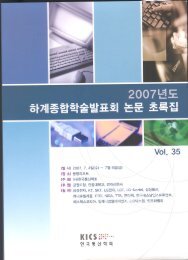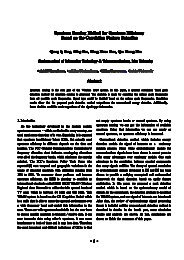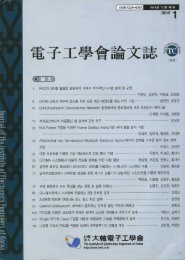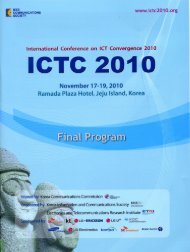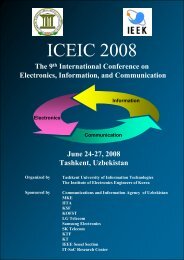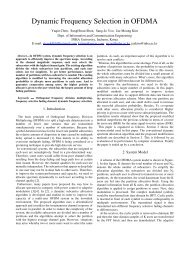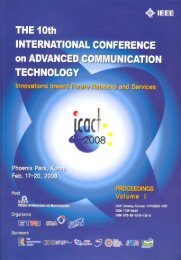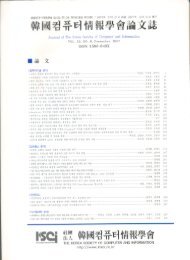Multi-partition Resource Allocation Mehtod Using Partial Channel ...
Multi-partition Resource Allocation Mehtod Using Partial Channel ...
Multi-partition Resource Allocation Mehtod Using Partial Channel ...
You also want an ePaper? Increase the reach of your titles
YUMPU automatically turns print PDFs into web optimized ePapers that Google loves.
<strong>Multi</strong>-<strong>partition</strong> resource allocation method<br />
using partial channel matrix<br />
in OFDMA system<br />
Myeong Geol Lee, Yuqin Chen, Sung Jun Lee, Sung Hwan Sohn, Jae Moung Kim<br />
The Graduate School of Information technology & Telecommunications INHA University, Incheon,<br />
Korea<br />
E-Mail : ddongri80@paran.com, river4416@sina.com, rhlek99@nate.com, kittisn@naver.com,<br />
jeakim@inha.ac.kr<br />
Abstract—In OFDMA system, resource allocation methods is an<br />
approach to efficiently improve the spectrum usage. According<br />
to the channel magnitude response each user selects the<br />
subcarriers with the highest channel gain. The existing<br />
algorithms allocate all required <strong>partition</strong> to users at one time,<br />
which cause increase in the complexity. And when the <strong>partition</strong><br />
per user increases, the successful allocation probability will be<br />
decreased rapidly. To support large amount of users, several<br />
procedures are proposed, among which the main idea is to<br />
allocate <strong>partition</strong> one by one until all users get enough <strong>partition</strong>s<br />
based on users priority and consider how to avoid to select<br />
channel <strong>partition</strong> with very serious channel quality gain.<br />
Index terms— Adaptive resource allocation, Orthogonal<br />
Frequency Division Modulation Access, frequency selective<br />
fading, Diversity<br />
I. INTRODUCTION<br />
Before 1990s, Spectrum usage had low economical value.<br />
Due to rapidly increasing demand on broadband wireless<br />
communication. Demand on the spectrum is increased always.<br />
It is difficult to use the resources at the same place and time<br />
if some users are using. This leads to the unsuitable<br />
frequency band to some users and sometimes give the low<br />
coefficient of utilization. To overcome this problem an<br />
efficient dynamic frequency allocation method is required for<br />
the proper usage of the spectrum.<br />
In order to provide high data rate services. Orthogonal<br />
frequency division multiplexing (OFDM) is being considered<br />
as a promising technique due to its ability to overcome<br />
multipath fading. The subcarriers experience deep fading to<br />
one user but may not be to other users. Therefore, to improve<br />
system capacity we allocate the spectrum dynamically to each<br />
users according to the channel quality.<br />
In general case, among the users using the same channel<br />
has difference communication environment owing to distance,<br />
geographical features, and multipath etc. So we have to<br />
allocate resources adaptively considering user’s<br />
communication environment. To efficiently allocating<br />
channel efficiency, In [1] the whole subcarriers are divided<br />
into a number of <strong>partition</strong> and each user acts in parallel and<br />
attempts to select the <strong>partition</strong> with highest average channel<br />
gain.<br />
In [2], method is proposed to divide the subcarriers into a<br />
large number of <strong>partition</strong>s and allocate several smaller<br />
<strong>partition</strong>s instead of one larger <strong>partition</strong> to each user. The<br />
users channel quality gain rows are copied to support<br />
different data rate of user’s matrix. In this method, K by K<br />
matrix is computed to solve conflict among users and the<br />
computation overload is too heavy.<br />
In this paper, to reduce complexity, we will suggest some<br />
method about the resource allocation base on the user’s<br />
channel impulse response. The rest of this paper is organized<br />
as follows, Section II describes <strong>Multi</strong>-Partition resource<br />
allocation method, and in Section III, we describe our<br />
simulation parameters and simulation result. In Section IV,<br />
we discuss performance analysis and finally in Section V we<br />
end up with conclusion.<br />
II. MULTI-PARTITON RESOURCE ALLOCATION<br />
METHOD<br />
A. Conventional algorithm<br />
In present systems, subcarriers which is assigned to each<br />
user are nonadaptively fixed. One way of allocating the<br />
available subcarrier is to divide them into as many <strong>partition</strong>s<br />
as there are users and then allocate one <strong>partition</strong> to each user
in a pre-determined manner. However, the above method<br />
does not take in account the fact that the channel magnitude<br />
response of each user varies across subcarriers. Thus, certain<br />
users are allocated <strong>partition</strong> that suffer from poor channel<br />
gains resulting large path loss and random fading. It can be<br />
seen that at each subcarrier, some user suffer from deep fade<br />
while others are able to achieve a high channel gain.<br />
It has two phase – initialization and iteration. In<br />
initialization phase, the channel magnitude response for each<br />
user is divided into a number of <strong>partition</strong>. After initial usage<br />
value of each <strong>partition</strong> is multiplied by a ranking factor in<br />
order to increase the probability of selection of the <strong>partition</strong><br />
with the highest average channel gain. Finally make the<br />
matrix of channel information K user by K <strong>partition</strong>.<br />
In iteration phase is carried out until each <strong>partition</strong> is only<br />
allocated to one user. During each iteration the set of usage<br />
value for each user is modified according to the selected<br />
<strong>partition</strong>s of the other users at the preceding iteration. In<br />
processing, many users select same <strong>partition</strong>, it can cause<br />
conflict. In order to solve the conflict between users for<br />
<strong>partition</strong> allocation, in [1] a novel method is proposed for<br />
modification of usage value of each <strong>partition</strong>. The modified<br />
usage value of each <strong>partition</strong> is based on the current usage<br />
value and the inhibition perceived by the <strong>partition</strong> under<br />
consideration. Consider the variables Un(t-1) as the usage<br />
value of Partition N during the previous iteration, CN as the<br />
cost of using Partition N, K as the total number of users in<br />
the system and w as the weight factor, then the usage of<br />
<strong>partition</strong> N during the current iteration is defined as follows<br />
U<br />
N ( t)<br />
= U<br />
N ( t)<br />
U N ( t)<br />
× ( 1−<br />
w)<br />
× w +<br />
CN<br />
+ 1<br />
+ 1<br />
( K −1)<br />
In [2], making more <strong>partition</strong> is diving each users into a<br />
number of <strong>partition</strong>. This leads to one user to select more<br />
than 1 <strong>partition</strong>. In more selective channel environment, this<br />
algorithm is more efficient. But dividing into more <strong>partition</strong><br />
requires larger matrix. If only 1 user has one <strong>partition</strong> we<br />
need K by K matrix. When divided into N <strong>partition</strong> makes K<br />
by N matrix and to apply this method, copying the user’s<br />
information in row makes N by N matrix. So this method<br />
needs complex calculation, more computation and when we<br />
copy the row of the same user we can get the same<br />
information and participation is competitive. This gives same<br />
result for every iteration which are able to allocate many<br />
<strong>partition</strong> to each user, base on [1] and [2].<br />
When each user has more than 2 <strong>partition</strong>, N by N matrix is<br />
computed to solve the conflicts among users. While doing so<br />
the computation overload is too heavy. <strong>Using</strong> the<br />
conventional algorithm, it leads to more competition and mis-<br />
(1)<br />
allocation of the band occurs. It leads to performance<br />
degradation. To reduce this complexity, in this paper we<br />
propose 1 simple method which are able to allocate many<br />
<strong>partition</strong> to each users base on [1].<br />
figure 1. Flow chart for proposed multi-<strong>partition</strong> resource allocation<br />
B. Proposed algorithm<br />
1) <strong>Partial</strong> <strong>Allocation</strong> Method<br />
Our main goal is to allocate users successfully. First we make<br />
K by N matrix based on the channel magnitude response.<br />
Next each user selects the best K channel and participates in<br />
the competition and makes another matrix. This matrix is<br />
only K by K. This matrix only has information, another K by<br />
(N – K) part is empty. <strong>Using</strong> the existing algorithm, it chose<br />
only one of the best channels for each user. By less iteration,<br />
we can allocate successfully. Next time the users choose the<br />
<strong>partition</strong> and make indexing (already allocated users). Again<br />
each user selects K (all user selects at least one <strong>partition</strong>)<br />
except indexing <strong>partition</strong> and chooses the best <strong>partition</strong> for<br />
each user.<br />
This process’s advantage is one time choice to participate in<br />
competition, and unselected <strong>partition</strong> don’t participate in the<br />
competition, we can avoid unnecessary competition.
Computation is lower using this method. And the probability<br />
of successful allocation to user is higher.<br />
figure 2. Flow chart for proposed worst_band first_allocation<br />
2) Worst Band-First allocation Method<br />
Another method is the selection of the <strong>partition</strong> to avoid<br />
the worst channel magnitude. Likely to partial allocation<br />
using the channel magnitude, make K by N matrix and<br />
summarize the whole band magnitude, the low magnitude<br />
user is near worst channel environment. We assume that this<br />
user’s channel is worst. So we first consider this band. In<br />
same band, the users that have the highest channel response<br />
are allocated this band. Next users having the lowest<br />
magnitude are considered and find the worst channel band<br />
and find the best user to use this band.<br />
This method is not sure that each user has the best channel.<br />
But it is certain that each user doesn’t choose the worst<br />
channel band, over the whole users has fair allocation. it is<br />
simple due to not using the matrix and no iteration. This only<br />
use the sorting method of <strong>partition</strong>. The computation load is<br />
very low<br />
III. SIMULATION PARAMETER AND RESULT<br />
In this paper we use follow system parameter and the ITU-R<br />
M.1225 channel profile parameters.<br />
ITU-R M.1225<br />
Vehicular A<br />
Table 1.<br />
System parameter<br />
Parameter Value<br />
System BW 6 MHz<br />
Modulation QPSK<br />
<strong>Channel</strong><br />
ITU-R M.1225<br />
Vehicular A,<br />
FFT Size 2K<br />
Number<br />
1728<br />
subcarrier<br />
Number of<br />
guard carrier<br />
320<br />
Table 2.<br />
<strong>Channel</strong> profile<br />
Path1 Path2 Path3 Path 4 Path 5 Path 6<br />
Excess delay 0 310 ns 710 ns<br />
Relative<br />
amplitude<br />
0<br />
-1.0<br />
dB<br />
-9.0<br />
dB<br />
1090<br />
ns<br />
-10.0<br />
dB<br />
figure 3. <strong>Channel</strong> frequency response<br />
1730<br />
ns<br />
-15.0<br />
dB<br />
2510<br />
ns<br />
-20.0<br />
dB<br />
Fig 4. shows the channel magnitude response for four users<br />
in M.1225 Vehicular A channel. We assume that each user<br />
has different position so they have different time delay and<br />
different power.<br />
In this system simulation, an FFT with 2048 subcarrier are<br />
allocated to 4, 8, 24, 48 uses, respectively. And the proposed<br />
methods are simulated in frequency selective fading with<br />
AWGN..<br />
Finally, it should be noted that no coding scheme is<br />
employed in order to test the effectiveness of the proposed<br />
algorithm.<br />
Simulation is varies with user number and <strong>partition</strong> number
BER<br />
1.E+00<br />
1.E-01<br />
1.E-02<br />
1.E-03<br />
1.E-04<br />
1.E-05<br />
1.E-06<br />
figure 4. An example of channel magnitude response and <strong>partition</strong> for four users , each method.<br />
BER vs SNR for Varying Number of Partitions<br />
A<br />
B<br />
C<br />
D<br />
24 users, 24 <strong>partition</strong> convetional Method<br />
24 users, 96 <strong>partition</strong> convetional Method<br />
24 users, 24 <strong>partition</strong> Worst_First Method<br />
24 users, 96 <strong>partition</strong> Worst_First Method<br />
1 3 5 7 9 11 13 15<br />
SNR(dB)<br />
17 19 21 23 25 27 29<br />
figure 5. Worst_first method performance<br />
Fig.5 is the Worst_First Method. A case, each user has 1<br />
<strong>partition</strong>. The performance is up to the expectation in the case<br />
of existing algorithm. But B is same number of user with<br />
larger number of <strong>partition</strong>. In this case, performance is<br />
degraded due to the complexity and there is allocation of the<br />
band. C is same condition performance is not as expected.<br />
But D case, when the <strong>partition</strong> is larger (96<strong>partition</strong>)<br />
proposed algorithm has good performance due to simplicity<br />
and diversity effect as compare to conventional algorithm<br />
(second line)<br />
Fig.6 is the partial Method’s result. A is the existing<br />
algorithm case. It has 48 <strong>partition</strong> it allocate whole spectrum.<br />
So this matrix is very complex. In this case, many bands are<br />
mis-allocated and performance degradation takes place. In<br />
B’s performance is little better due to frequency diversity.<br />
C,D are our proposed algorithm. It reduces the complexity<br />
and performance is stable.<br />
Fig.7 is performance of fixed number of users with varying<br />
number of <strong>partition</strong>. As the number of <strong>partition</strong> increased, the<br />
result shows that there is high increase in the performance.<br />
But more than certain number of <strong>partition</strong> is saturated. It<br />
shows the frequency diversity effect.
Figure 8 case is fixed 4 users, the number of <strong>partition</strong> is<br />
increased. The number of <strong>partition</strong> is larger, we can get user<br />
and frequency diversity effect by successful allocation using<br />
the partial method.<br />
BER<br />
BER<br />
1.E+00<br />
1.E-01<br />
1.E-02<br />
1.E-03<br />
1.E-04<br />
1.E-05<br />
1.E+00<br />
1.E-01<br />
1.E-02<br />
1.E-03<br />
1.E-04<br />
1.E-05<br />
1.E-06<br />
BER vs SNR for Varying Num ber of Partitions<br />
A<br />
B<br />
C<br />
D<br />
24 users, 48 <strong>partition</strong> convetional Method<br />
24 users, 96 <strong>partition</strong> convetional Method<br />
24 users, 48 <strong>partition</strong> <strong>Partial</strong> Method<br />
24 users, 96 <strong>partition</strong> <strong>Partial</strong> Method<br />
1 3 5 7 9 11 13 15 17 19 21 23 25 27 29<br />
SNR(dB)<br />
figure 6. Performance of partial allocation method<br />
BER vs SNR for Varying Num ber of Partitions<br />
4 users, 2 <strong>partition</strong> per user<br />
4 users, 6 <strong>partition</strong> per user<br />
4 users, 12 <strong>partition</strong> per user<br />
4 users, 24 <strong>partition</strong> per user<br />
4 users, 48 <strong>partition</strong> per user<br />
1 3 5 7 9 11 13 15 17 19 21 23 25 27 29 31<br />
SNR(dB)<br />
figure 7. Performance according to varying number of <strong>partition</strong> using partial<br />
method<br />
IV. CONCLUSION<br />
If we use the frequency and the user diversity, we can get<br />
better performance. But this consideration is complex for<br />
existing algorithm. Our proposed algorithm is suitable under<br />
this situation reducing the complexity. We verify this method<br />
using computer simulation. And high performance is<br />
achieved.<br />
BER<br />
1.E+00<br />
1.E-01<br />
1.E-02<br />
1.E-03<br />
1.E-04<br />
1.E-05<br />
1.E-06<br />
BER vs SNR for Varying Number of Partitions<br />
1 3 5 7 9 11 13 15 17 19 21 23 25 27<br />
SNR(dB)<br />
4 users, 6 <strong>partition</strong> per user<br />
12 users, 6 <strong>partition</strong> per user<br />
24 users, 6 <strong>partition</strong> per user<br />
figure 8. Performance according to varying number of users with fixed<br />
<strong>partition</strong>’s per user<br />
ACKNOWLEDGEMENT<br />
This work was supported by Korea Science & Engineering<br />
Foundation through the NRL Program<br />
(M1060000019406J000019410)<br />
V. REFERENCE<br />
[1] Teo Choon Alen, A.S. Madhukumar , Francols Chin,<br />
“Capacity enhancement of a multi-user OFDM system<br />
using dynamic frequency allocation”, IEEE Trans.<br />
Braodcast. , vol.49, 2003, pp. 344-353.<br />
[2] Yuqin Chen, SungHwan Sohn, Sang-jo Yoo, Jae Moung<br />
Kim, “Dynamic Frequency Selection in OFDMA”,<br />
ICACT. 2006<br />
[3] Richard van Nee, Ramjee Prasad, “OFDM fore wireless<br />
multimedia communications”, Artech House Publishers,<br />
Boston London, 2000<br />
[4] Mustafa Ergen, Sinem Coleri, and Pravin Varalya, “QoS<br />
aware adaptive resource allocation techniques for fair<br />
scheduling in OFDMA based broadband wireless access<br />
systems”, IEEE Trans. Broadcast., vol. 49, 2003 pp.362-<br />
370<br />
[5] C.Y. Wong, C.Y.Tsui, R.S.Cheng. and K.B. Letaief, “A<br />
real-time subcarrier allocation scheme for multiple<br />
access downlink OFDM transmission, “In Proc. VTC<br />
1999, vol.2, 1999, pp1124-1128.



